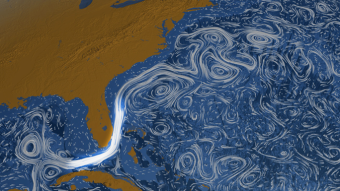A new study, co-authored by scientists at the National Oceanography Centre (NOC), has found that a key component of a major system of ocean currents that keeps the Northwest European climate mild has remained stable for the past four decades.
The study of the Florida Current, which forms a major part of the Atlantic Meridional Overturning Circulation (AMOC) – bringing heat from the tropics to north-west Europe –counters previous reports, which have showed both to be slowing down.
Scientists say that this could be because a slowing AMOC, predicted in models, hasn’t yet impacted the Florida current or that four decades isn’t long enough to show changes.
The study was led by the US National Oceanic and Atmospheric Administration’s Atlantic Oceanographic and Meteorological Laboratory (AOML), alongside NOC and the University of Miami’s Cooperative Institute for Marine and Atmospheric Studies (CIMAS).
“There is growing interest in the AMOC, a complex system of ocean currents and eddies that form a huge vertical loop spanning the whole length of the Atlantic Ocean,” says study co-author, Dr Ben Moat, senior scientist at NOC.
“By moving heat, freshwater, carbon, nutrients and other properties around, it can have a major impact on our weather systems and climate. Most current climate models, predicting its behaviour, suggest its strength could decline by up to 45% towards the end of this century. However, there is limited observational evidence.
“Our latest study, using observations of the Florida Current, which feeds to Gulf Stream and is a major part of the AMOC, shows that it has remained remarkably stable over the past 40 years and reduces our estimate of the reduction of the AMOC over the last 20 years.
“If climate models are correct that the AMOC is slowing or will slow down, this study indicates that such a slowdown has not yet been reflected in the Florida Current or that the observational records are still too short to detect it with confidence.”

The latest study re-assessed data from NOAA’s Western Boundary Time Series (WBTS) project and its predecessors, which date back to 1982, and use a 120-km long subsea telecoms cable and data gathered by research vessels to monitor the Florida Current.
Previous studies hadn’t accounted for the gradual change in the Earth’s magnetic field over time, which impacts the cable data. After correcting for this, the authors found that a previously reported weakening in the Florida Current was cancelled out and that it has remained stable for the past four decades.
This result in turn reduces a weakening also previously observed in the AMOC, between 2004–2022, by about 40%, due to the cable data also contributing to AMOC calculations.
“Although the AMOC observing system at 26.5N has 20 years of observations, the time series is still too short to draw definitive conclusions,” he adds. “Our study focuses on the long-term change in the Florida Current strength, which is an important component of the AMOC,” says Denis Volkov, CIMAS scientist and lead author of the study.
“However, it is possible that the AMOC is changing without a corresponding change in the Florida Current. The AMOC may still be weakening and/or what we are observing is just part of the interdecadal variability – we still need to find out.”
The WBTS project is part of an international collaboration which partners include AOML’s WBTS, which is funded by NOAA’s Global Ocean Monitoring and Observing (GOMO) Program, the University of Miami’s Rosenstiel School of Marine, Atmospheric, and Earth Science (UM/RSMAS) Meridional Overturning Circulation and Heat-flux Array (MOCHA) Program (funded via the National Science Foundation, NSF), and NOC’s Rapid Climate Change (RAPID) Programme (funded by the Natural Environment Research Council).
The corrected Florida Current transport time series is made freely available through the WBTS project’s webpage.
Dive under the surface
Learn more: read the full study here.
You can also find out more about the AMOC, what it is, what we know about it and the research we’re doing at NOC.

